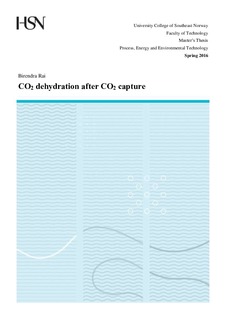| dc.description.abstract | The presence of free water is considered as one of the major impurities for the pipeline transportation of gas. Corrosion and hydrate formation in the process plant equipment are common problems associated with the free water. The gas dehydration process has been the most preferred method. Water absorption followed by glycol regeneration are the key stages of a gas dehydration unit.
Although, being in operation for a long period of time there are no rationale standards for water content requirements in the dehydration of gas. Water specifications between 5 and 500 ppm (parts per million) are generally considered. Only a few references have been published on simulation of CO₂ dehydration based on absorption in glycol.
All the simulations have been performed in Aspen HYSYS version 8.0 using Peng-Robinson (PR) and Twu-Sim-Tassone (TST) equilibrium models. The results from the TST model are considered to be the most accurate for glycol dehydration.
Several parameters such as absorption pressure, glycol flow rate, number of absorption stages, and stripping gas flow rate were varied to simulate their effects on water removal efficiency.
The simulation results of a traditional triethylene glycol dehydration process showed optimum dehydration efficiency at a pressure of 5000 kPa with resulting water content of 129 ppm using PR and 105 ppm using TST model.
The traditional dehydration process was enhanced by introducing stripping gas to the reboiler and by adding an extra stripping column. Simulations show that injecting stripping gas to the reboiler can dehydrate gas down to 30 ppm. With an additional extra stripping column, water content was reduced down to about 1 ppm. A Drizo process was also simulated which calculated less than 1 ppm water in dehydrated CO₂. | nb_NO |
